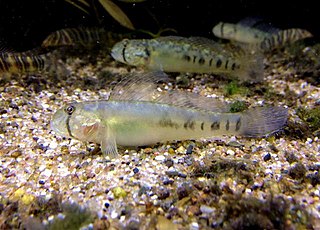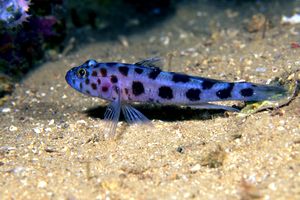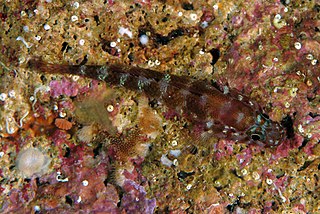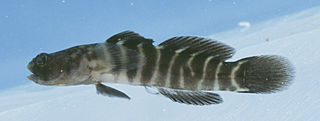
Gobiidae is a family of bony fish in the order Gobiiformes, one of the largest fish families comprising more than 2,000 species in more than 200 genera, sometimes referred to as the "true gobies". Most of them are relatively small, typically less than 10 cm (3.9 in) in length. The Gobiidae includes some of the smallest vertebrates in the world, such as Trimmatom nanus and Pandaka pygmaea,Trimmatom nanus are under 1 cm long when fully grown,then Pandaka pygmaea standard length are 9mm (0.35 in),maximum known standard length are 11 mm (0.43 in). Some large gobies can reach over 30 cm (0.98 ft) in length, but that is exceptional. Generally, they are benthic, or bottom-dwellers. Although few are important as food for humans, they are of great significance as prey species for commercially important fish such as cod, haddock, sea bass, and flatfish. Several gobiids are also of interest as aquarium fish, such as the dartfish of the genus Ptereleotris. Phylogenetic relationships of gobiids have been studied using molecular data.
Schindleria is a genus of marine fish. It was the only genus of family Schindleriidae, among the Gobioidei of order Perciformes but is now classified under the Gobiidae in the Gobiiformes. The type species is S. praematura, Schindler's fish. The Schindleria species are known generically as Schindler's fishes after German zoologist Otto Schindler (1906–1959), or infantfishes. They are native to the southern Pacific Ocean, from the South China Sea to the Great Barrier Reef off eastern Australia.

Brachygobius is a small genus of gobies. They are popular aquarium fish where a number of species are sold as bumblebee gobies because their colours are similar to those of bumblebees.

Gobius is a genus of fish in the family Gobiidae native to fresh, brackish and marine waters of and around Europe, Africa and Asia. It contains the typical gobies, being the type genus of the formerly recognised subfamily Gobiinae and family and the namesake genus of its order Gobiiformes.

Knipowitschia is a genus of marine, fresh and brackish water gobies native to Eurasia. The genus name almost certainly honours Nikolai Mikhailovich Knipovich (1862-1938), a biologist who led a number of expeditions to the Caspian Sea.

Neogobius is a genus of goby native to Black Sea and the Caspian Sea basins. It is part of the broader Benthophilinae subfamily which is also endemic to the same region. Nevertheless, two Neogobius species have recently turned out to be highly invasive and spread across Europe and even to the Great Lakes of North America.

Oligolepis is a genus of fish in the goby family Gobiidae, native to marine, fresh and brackish waters of the coastal areas of the Indian Ocean and the western Pacific Ocean.

True gobies were a subfamily, the Gobiinae, of the goby family Gobiidae, although the 5th edition of the Fishes of the World does not subdivide the Gobiidae into subfamilies. They are found in all oceans and a few rivers and lakes, but most live in warm waters. Altogether, the Gobiinae unite about 1149 described species in 160 genera, and new ones are still being discovered in numbers.

Pectenocypris is a genus of small fish in the family Cyprinidae endemic to freshwater habitats in Borneo and Sumatra in Indonesia.

Lesueurigobius is a genus of gobies native to the eastern Atlantic Ocean. The generic name honours the French naturalist Charles Alexandre Lesueur (1778-1846), for whom the type species, Lesueurigobius suerii, was named, Georg Duncker's name Lesueuria being preoccupied by a genus of comb jellies.

Didogobius is a genus of small marine fish in the family Gobiidae, the true gobies. They are native to the eastern Atlantic Ocean and the Mediterranean Sea. The name of the genus is a compound noun made up of Dido, the mythical founder and first queen of Carthage, and the Latin gobius meaning "goby".

The blind goby is a species of fish in the goby family, the only species in the genus Typhlogobius. It is native to the coastlines of southern California in the United States and Baja California in Mexico, where it commonly inhabits the burrows of shrimp of the genus Callianassa. The adult of the species is completely blind and lacks pigmentation, while the juvenile has rudimentary eyes that help it find the shrimp burrows. This species can reach a length of 8.3 centimetres (3.3 in) TL.

Thorogobius ephippiatus, the leopard-spotted goby, is a species of goby native to the eastern Atlantic Ocean and the Mediterranean Sea.

Steinitz's goby is a species of goby. It is native to the Mediterranean Sea near Marseilles. Recently recorded in the Adriatic Sea in Croatia, Tyrrhenian Sea in Italy, and in the Black Sea in Ukraine. This species can be found in underwater grottoes in inshore waters at depths of from 2 to 15 metres. It can reach a length of 3.8 centimetres (1.5 in) SL. The specific name honours the marine biologist and herpetologist Heinz Steinitz (1909-1971) of the Hebrew University, Jerusalem.
Bollmannia is a genus of gobies native to the Atlantic and Pacific coasts of the Americas. The generic name honours the American naturalist Charles Harvey Bollman (1868–1889).
Chriolepis is a genus of gobies native to the Atlantic and Pacific coasts of the Americas.

Gobiosoma is a genus of gobies native to fresh, brackish and marine waters of the Americas.
Quietula is a genus of fish in the goby subfamily, Gobionellinae. There are two species, both native to the Gulf of California in Mexico. One is endemic to the Gulf, and the other also occurs along the western coast of Baja California and the coast of California. The fish were first described from Guaymas in Sonora, Mexico. The genus name Quietula is from the Latin quietus, meaning "quiet".

Goby is a common name for many species of small to medium sized ray-finned fish, normally with large heads and tapered bodies, which are found in marine, brackish and freshwater environments. Traditionally most of the species called gobies have been classified in the order Perciformes as the suborder Gobioidei but in the 5th Edition of Fishes of the World this suborder is elevated to an order Gobiiformes within the clade Percomorpha. Not all the species in the Gobiiformes are referred to as gobies and the "true gobies" are placed in the family Gobiidae, while other species referred to as gobies have been placed in the Oxudercidae.. Goby is also used to describe some species which are not classified within the order Gobiiformes, such as the engineer goby or convict blenny Pholidichthys leucotaenia. The word goby derives from the Latin gobius meaning "gudgeon", and some species of goby, especially the sleeper gobies in the family Eleotridae and some of the dartfishes are called "gudgeons", especially in Australia.
















